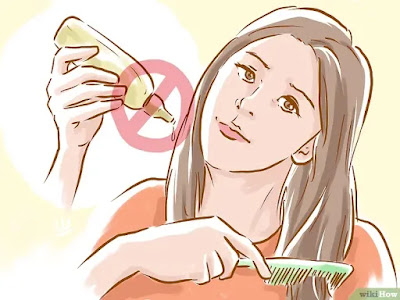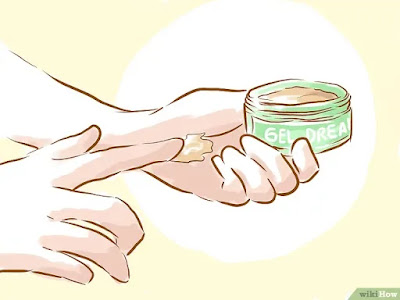Stretching your hair does not require much in addition to the special hair wax style of gimbal and extra patience. You can indeed hairdo in the salon, but doing it yourself at home will be more natural and only cost much cheaper. Set aside time for several months to form dreadlocks and afterwards to maintain the appearance.
1. Start with clean hair. Make sure that your hair is clean and free of any material residue, so that the process can be done more quickly. Natural oils that accumulate on the surface of the hair will make it slippery, so you better start with a hair that has just been shampooed.
Do not put any conditioner or other hair product on your hair after wash.
Make sure that your hair is completely dry before you begin the process.
2. Separate your hair into multiple part plots. Each plot will form a strand of gimbal. You are free to determine the size of this dreadlocks later. For a look that looks more tidy in general, try to make each of the dreadlocks the same size.
Use a sparse-toothed comb to separate your hair and put a limit on each plot. Hold the hair position on each patch using a small rubber band.
Plots of 2.5 x 2.5 centimeters will produce standard and medium-sized dreadlocks. Plots of 1.25 X 1.25 centimeters will produce a smaller and more elegant dreadlocks. Remember that the more plots you make, the longer the time you need to make the form of the dreadlock.
The lines of the hemisphere and the rows of the plot will be seen on the final result of the dreadlock later. In order not to look too patterned, kreasikan plots form a zigzag or pile up each other like a brick building to create a more natural look that looks more natural.
3. Cook each hairline. Hold one part of the hair on the patch by pulling it out of the head. Begin at a distance of about 2.5 centimeters from the scalp, then use a tight-fisted comb to brush it against the scalp. Repeat this cooking technique several times on the part of the hair being worked on, until the hair appears to expand and gather at the root. Continue to cook this part of the hair, moving at a distance of 2.5 centimeters at each stage, until all the hair in the part of the patch has been braced to the scalp. Tighten the end with a rubber band.
When cooking with one hand, use the other hand to twist gently the part of the hair being worked on. This will hold the hair in the right position and help the process of tasting.
Continue to cook each part of the hair using the same technique, until all parts of the hair finished cooked. This process can be done faster with the help of a friend.
Be patient and apply the same precautions to each of the dreadlocks. If you are in a hurry to finish the final part of the hair, you will produce a series of uneven-looking dreadlocks.
4. Tie the dreadlocks. Each of the dreadlocks must be tied with a rubber band at the end. Tie a second rubber band to each of the dreadlocks at the point just above the scalp. Both rubber bands will hold the position of the thread while the form of the gimbalnya become more "mature".
5. Dab special hair wax for dreadlocks style. Use hair wax from natural materials or jelly hair which is hardened on the entire length of the dreadlocks, and apply on the entire surface of the hair, but thinly. If you choose to use wax, do this for 2-4 weeks.
Many people with dreadlocks do not use hair wax or hair jelly, because they think these materials can interfere with the process of dribbling. Determine your own decisions by understanding the risks.
1. Regular shampooing will help the dreadlocks form closer and smoother, and the entire "hardening" process will last for at least three months. Use a special soap or shampoo for dreadlocks, or other shampoos that also do not contain fragrance and conditioner, as these two materials can be tucked into the sidelines of the dreadlocks and make them smell.
When shampooing, pay special attention to your scalp. Do not hold dreadlocks too hard, because this can risk breaking them.
Shammer in the morning, so that the strands of the dreadlock had dried up. If you go to bed with wet hair, your hair can be overgrown with fungus.
2. Put moisturizer on your dreads. Use a mixture of oil and water sprayed on the dreadlocks every few days to keep them from engering and breaking. Choose essential oils such as tea tree oil or lavender oil. Do not put too much oil, so your dreads do not look greasy. A single spray once every few days is enough.
Do not use vegetable oil, olive oil, or any other food based oil on your dreadlocks. These types of oils will be absorbed into the hair and make it smell bad.
Special moisturizing agents for dreadlocks can be purchased at online stores.
3.Project the strands of hair that are detached. Daily activity inevitably will result in some strands of your hair apart from the dreadlocks. Use a knitting tool or tweezers to tuck back these loose hair strands into the dreadlocks.
4. Roll the strands of dreadlocks and bend the ends. To keep the gimbal shapes smooth, you can roll them with both hands regularly. Make it appear rounded by pressing it on the palm of the hand, so that the hair bends inward toward the strands.
If you prefer a pointed tip, you do not have to bend the ends of a string.
Do not roll the strands of dreadlocks excessively, because this can precisely lead to more easily loose gimbal loose.
1. Remove the rubber band. Once the dreadlocks form fully hardened, you no longer need to hold them with the aid of a rubber band. Remove the rubber band from the root part of the hair and the end of the strand after about three months.
2. Rub the roots of the hair. During the process of forming a dreadlocks, the strands of hair will be intertwined naturally. However, the strands of newly grown hair are straight and unbreakable, and you need a little effort to put them in the existing dreadlocks. Scrub off the roots of your hair with your fingers, each part one at a time, to help it wove into the existing gimbal strands.
You do not have to rub the roots of hair too often. As your dreads begin to become more mature, new hair grows naturally at a distance of about 2.5 centimeters from the scalp.
Be careful that you do not pull the roots of the hair too hard, because this can lead to broken hair part and loose.
3. Stay dry. Oil and other ingredients that accumulate in the scalp will make hair grow straight, making it difficult to put in existing gimbal strands. Keep the newly grown hair strands clean and dry, in order to blend naturally with all parts of the dreadlocks.
4. To clean your hair naturally and cheaply, use about 1/4 cup baking soda and apply to a completely moistened scalp. To remove dirt and baking soda powder from the dreadlocks, rinse or soak your hair in a water mixture and apple vinegar with a 3: 1 ratio. Once done, rinse your scalp and dreadlocks until it is completely clean. Do not get any material left, because this will make it smell bad.
Tips
If you want to rearrange dreadlocks, there is an alternative to cutting your hair out. Some companies (for example, Knotty Boy in the US) produce packages of dandruff gum and equipment that can break down and moisturize your hair shaft. Maybe afterwards, your hair needs to be cut and trimmed to remove the cracked edges, but the shape of the gimbal will break down again.
You can do many things to beautify the appearance of dreadlocks. For example, you can color it, put on a bead, or wrap it around with felt fabric so that dreadlocks look more stylish.
To avoid what is commonly thought that dreadlocks must smell like "wet dog smell", do not start forming a dreadlock if your hair is not really dry, because this must make your hair smell like that.
Roll your hair with your palms in the same direction, while still damp. Water is a jelly or natural hair wax. Dry after rolling and twisting, then the result will not be released as long as you do it correctly.
Do not worry, any kind of hair can and will form dreadlocks, even without the addition of hair products or business too hard. Just relax, and let your hair harden and unleash by itself.
The whole process of making the hair will make your hair look shorter. Its average length is one-third of the length of unbranded hair.
Make your dreadlocks more unique by wrapping the strands with a certain material or by wearing beads.
Use the "Vital Goods" brand shampoo. This shampoo is completely residue free and 100% natural.
WARNING
Use rubber bands only when making hair partitions. Remove the rubber bands before brushing the hair. If not removed, the rubber band will be much more difficult to release in the next stage-resistant.
These methods and their suggestions are suitable to apply to straight, wavy, or curly hair, but will result in unnecessary damage to friable hair. Learn more from various sources about troubling the specific hair type you have, before starting the process of dribbling.
Do not pull the dreadlocks after the process is over for so long.













